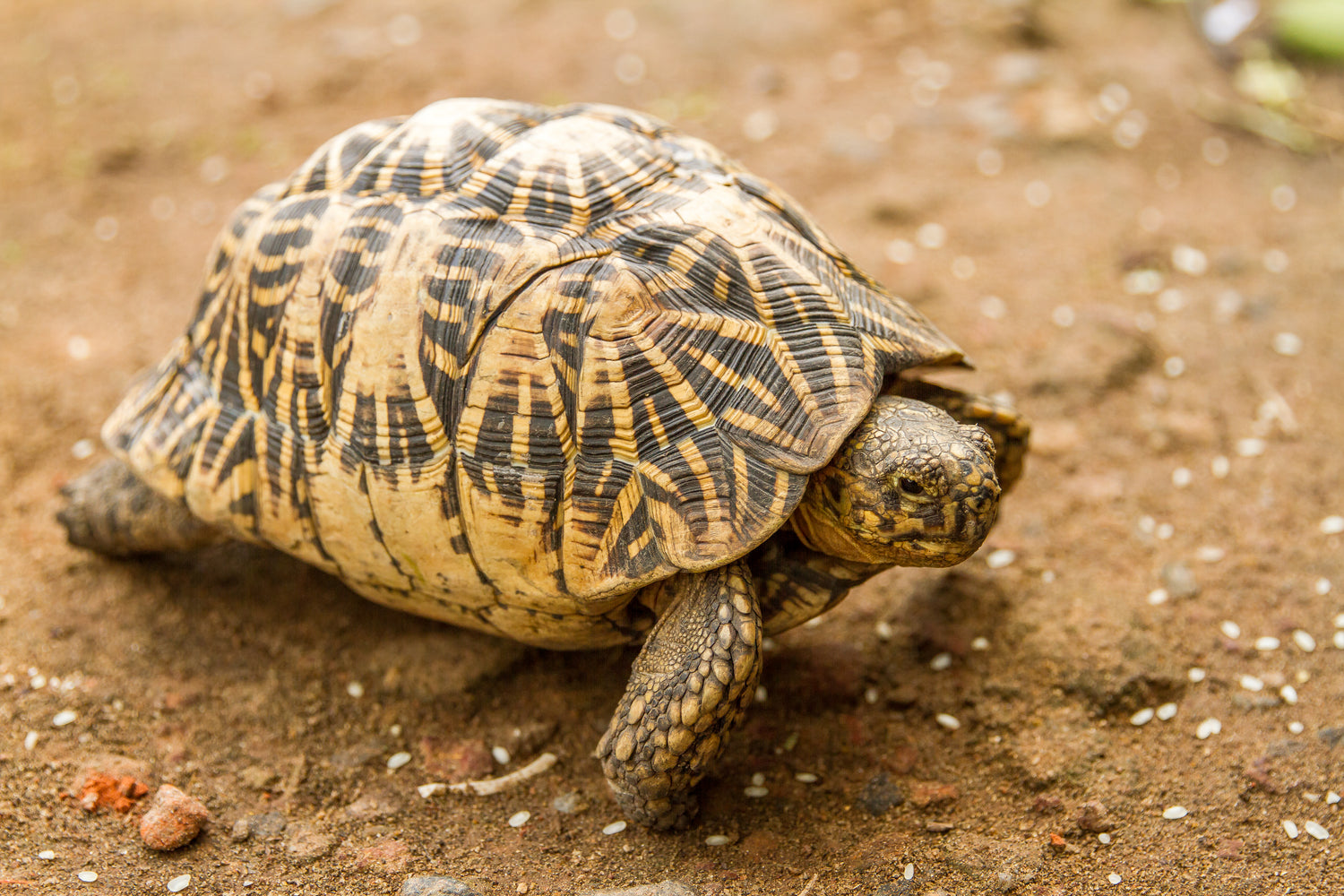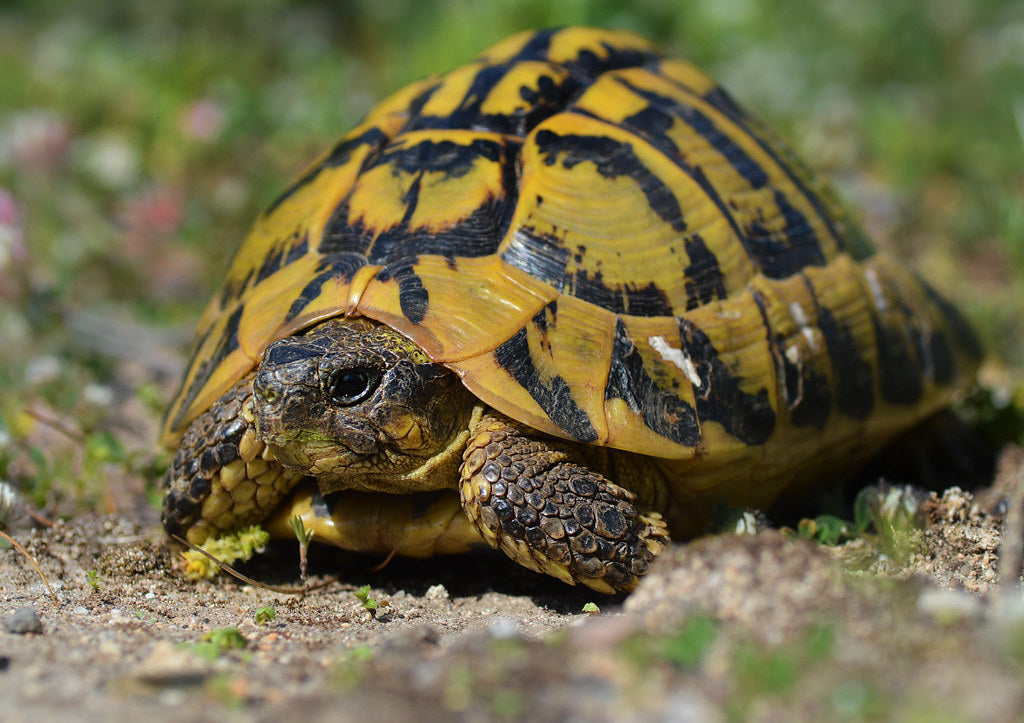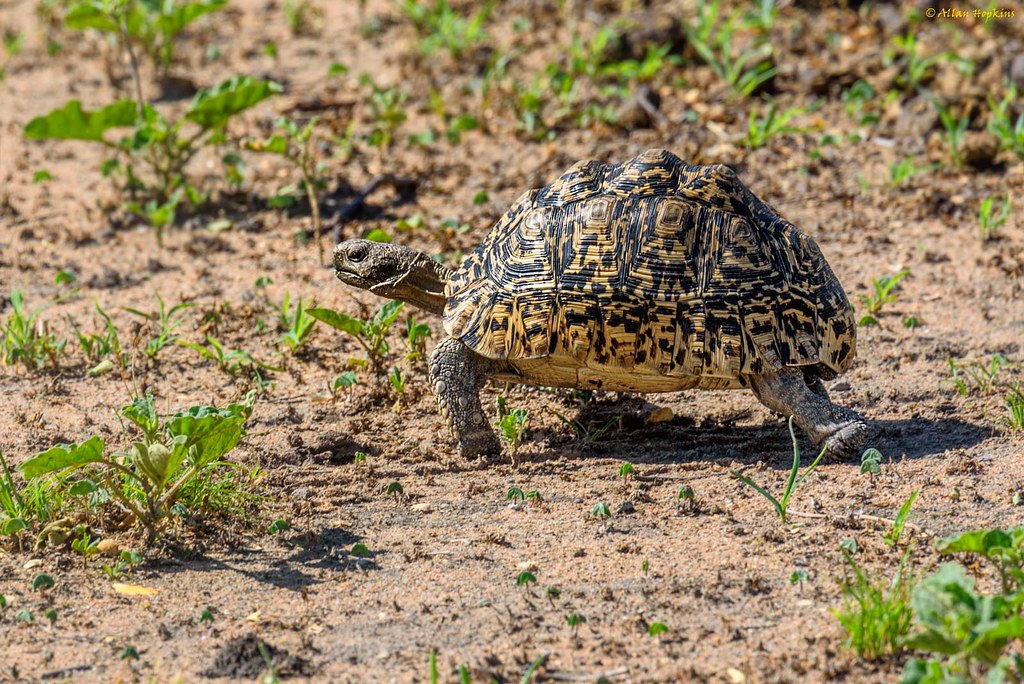Indian tortoises (Geochelone elegans) are a diurnal, terrestrial reptile native to India, southeastern Pakistan, and Sri Lanka. Their habitat is generally semi-arid grasslands, but also includes forest and semi-desert.
Indian star tortoises are generally 6-12” long, with females being significantly larger than males. They have a highly domed, sometimes bumpy, shell, with enlarged scales on the forelimbs. They are best known for the unusual pattern that serves as their namesake: a black shell covered in a cream to yellow pattern of “stars” on each scute. The plastron has dark radiating lines on a cream to yellow background.
Indian star tortoises are prized for their beauty and supposed medicinal properties, which has led to a thriving illegal market, and thousands are rescued from poachers every year. Wild-caught individuals generally do very poorly as pets, so if you want a pet Indian star tortoise, make sure to buy captive-bred from a reputable breeder!
How much space do Indian star tortoises need?
Indian star tortoises can be kept indoors in a 4’L x 4’W or larger tortoise table, as they prefer dry conditions and can do well in this type of enclosure as long as they have access to a humid microclimate such as a moist hide.
However, whenever possible, it’s best to house Indian star tortoises outdoors. They are poor diggers and climbers, so escape is unlikely. Walls should be at least 8 inches tall to provide a visual barrier to the rest of your yard, and it should have some kind of predator prevention measure in place.
Although multiple Indian star tortoises can usually be housed together without problems as long as they have extra space, they should NEVER be housed with other species, as this is likely to make them sick.
Do Indian star tortoises need UVB?
Yes. Aside from helping provide a day/night cycle and an infinite supply of vitamin D, UVB is also essential to your tortoise’s overall health. If you are housing your tortoise outdoors, then this is not something you need to worry about, because they will get all the UVB they need from sunlight.
If you are housing your tortoise indoors, however, you will need to provide artificial UVB. The best UVB bulbs for Indian star tortoises are:
- Arcadia T5 HO 12%
- Zoo Med T5 HO Reptisun 10.0
When the bulb is mounted in a Zoo Med Reptisun T5 HO Terrarium Hood fixture without mesh obstruction, it should be placed 6-8” above the top of the tortoise’s shell in the basking area. Bulbs mounted in the Arcadia ProT5 fixture can be placed further away: 17-18” above the tortoise’s shell. The UVB bulb and fixture should be roughly half the total length of the enclosure.
A single UVB bulb will not be enough to sufficiently illuminate your enclosure, even if the lights are on in the room with the tortoise table. Add a strong 6500K LED or T5 HO fluorescent grow light to energize your tortoise and better simulate daylight.
All lighting should be on for only 12 hours/day.
What basking temperatures do Indian star tortoises need?
If you are housing your Indian star tortoise outdoors, they do best when nighttime temperatures don’t dip below the 50s. When local weather is consistently in the 50s or lower, it’s time to bring your tortoise indoors until the weather warms up again, as Indian star tortoises do not hibernate. To defend against cool nights, your tortoise should have access to a warm tortoise shelter heated to 60-70°F. Part of the outdoor pen should always be shaded so your tortoise isn’t in danger of overheating.
If you are housing your Indian star tortoise indoors, they will need a basking temperature of 90-100°F, with a cool area on the other side of the enclosure between 75-85°F. Temperature should be measured with digital probe thermometers.
Use at least one halogen heat lamp placed on one side of the enclosure to create a basking area, mounted at least 8” above your tortoise’s shell to provide even heating. Do not use ceramic heat emitters (CHEs), heat mats, red bulbs, or blue bulbs, as these are not as effective. However, if your room is cool, a radiant heat panel may be required in addition to the heat lamp to maintain comfortable ambient temps during the day.
Heating should be turned off at night.
What humidity levels do Indian star tortoises need?
As a semi-arid species, Indian star tortoises can survive fairly low humidity levels. In fact, consistent wet is a quick way to make this species sick! However, higher humidity is critical for young Indian star tortoises to grow and develop properly. If housed indoors, it is helpful to keep them in a fully or partly enclosed terrarium with 70-80% average humidity. Adults prefer moderate humidity between 40-75%. Humidity should be measured by a digital probe hygrometer with the probe in the middle of the terrarium.
If you are housing yours outdoors, humidity is less of a concern. Occasionally wetting down the cool side of the enclosure with a hose and using live plants inside the pen is helpful. However, always make sure that your tortoise can fully warm up and dry off!
What substrate is good for Indian star tortoises?
It’s ideal to use a substrate that imitates what Indian star tortoises naturally live on in the wild. In other words, you’ll need something that resembles sandy soil. It should have small particles, not be too dusty, and pack well enough for burrowing.
Plain topsoil mixed 60/40 with play sand works well as a substrate for Indian star tortoises. However, grass hay is a popular choice for indoor enclosures, and can work well as long as it is kept very clean.
Soil substrate should be at least 4” deep and completely replaced at least every 3-4 months in indoor enclosures. Remove poop and urine daily, along with contaminated substrate. Hay substrate should be replaced daily.
What décor can you use in an Indian star tortoise enclosure?
It’s terribly boring for a reptile to be stuck in an enclosure with nothing in it except substrate, a hide, and food/water bowls. It doesn’t matter how big the enclosure is if you don’t put things in it for your pet to use and interact with.
Here are some décor ideas that are appropriate for Indian star tortoises:
- additional hiding places/burrows
- hollow logs
- live, edible plants
- large, flat stones
You can also shape the substrate into hills to provide an extra challenge. Make sure, however, that your tortoise can’t flip itself over!
For outdoor enclosures, it’s best to plant a variety of drought-tolerant, grazer-resistant edible weeds and grasses. The Tortoise Table is a helpful resource for figuring out which ones are safe to plant.
What do Indian star tortoises eat?
Indian star tortoises are herbivorous, which means that they require a high-fiber diet. They do best on a diet of mostly grasses and weeds (90%), with a small amount of “grocery store” greens and other vegetables (10%).
Safe grasses/leaves for Indian star tortoises: lawn grass (untreated), mulberry leaves, grape leaves, hibiscus leaves, meadow hay, oat hay, orchard hay, timothy, Bermuda, rye, clover, dandelion, nasturtium, geranium, thistle
Safe greens and vegetables for Indian star tortoises: cactus pads, kale, collard greens, turnip greens, mustard greens, romaine lettuce, red leaf lettuce, chicory, endive, escarole, radicchio, carrot, bell pepper, squash
Edible flowers like nasturtium, dandelions, geranium, roses, and hibiscus are great to add for variety and extra vitamins. Fruits should be avoided.
Food should be offered daily, served on a plate or tray to prevent substrate ingestion. If your tortoise is starting to look chubby, reduce the amount of food that you offer per day.
Supplements
You will also need calcium and vitamin supplements to prevent your tortoise from developing a potential deficiency. We recommend Repashy Superveggie, lightly dusted on each meal. A little bit of Mazuri grassland tortoise formula or Zoo Med Natural Grassland Tortoise Food is also a good way to make sure your tortoise is getting enough vitamins.
Your tortoise should always have access to a cuttlebone for calcium.
Water
Of course, don’t forget a water dish for your tortoise to drink from! To keep your tortoise hydrated, offer a very shallow “puddle” of water for them to drink from and soak themselves in. However, babies should only have access to a very shallow pan of water, and soaked outside of the enclosure 3x/week for 15-30 minutes. The water should be no deeper than your tortoise’s elbows.
Always keep the water clean and scrub the bowl with a reptile-safe disinfectant weekly.
Do Indian star tortoises like to be handled?
Like most tortoises, Indian star tortoises should not be picked up when it’s not necessary. However, they do respond well to hand-feeding and gentle head or shell rubs.
*This care sheet contains only very basic information. Although it’s a good introduction, please do further research with high-quality sources to obtain additional information on caring for this species.
"File:Star Tortoise (Geochelone Elegans) 01.jpg" by M Kooragamage is licensed under CC BY-SA 4.0




Leave a comment
This site is protected by hCaptcha and the hCaptcha Privacy Policy and Terms of Service apply.